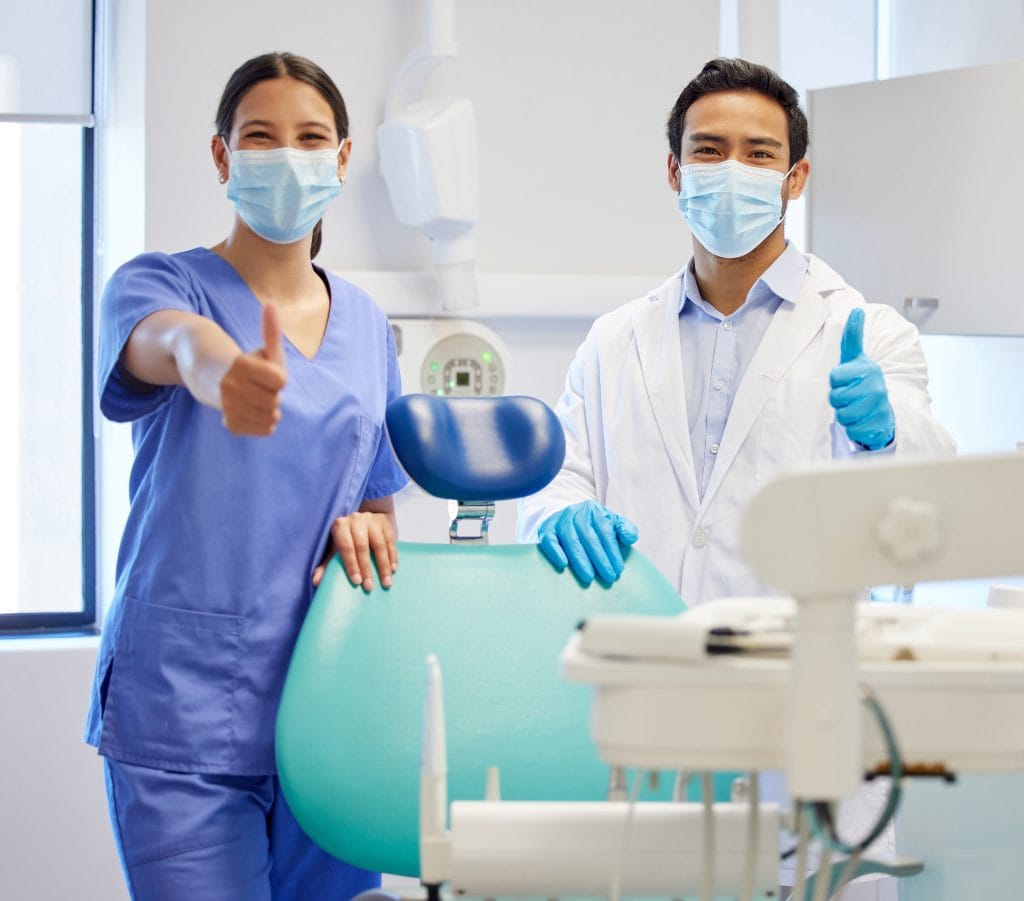Last updated on June 7th, 2023 at 11:01 am
 It’s one thing to just do what’s expected of you as a dental practice, but it’s an entirely different thing to be a dental office that goes above and beyond for their patients.
It’s one thing to just do what’s expected of you as a dental practice, but it’s an entirely different thing to be a dental office that goes above and beyond for their patients.
Your patients can either be content and healthier… or they can be over-the-moon happy and fully healthy!
So, if you really want to give the best experience and utmost care to your patients—and improve practice productivity—you need to be doing this one simple thing for 10 minutes every day:
An effective morning huddle.
There are a few specific things you should be doing in your morning huddle to greatly improve patient care and case acceptance—and get you more referrals and more 5-star reviews. And I’m about to tell you how you can start doing this tomorrow morning.
The proper format for an effective morning huddle (or morning production meeting) can be found here. I highly suggest reading it and giving it to your whole team. Or even better—use the courses on our on-demand video training platform, DDS Success. You can do a free demo here.
And now, I have a few more tips to help you get the most out of it:
Prepare your team for the meeting

The first thing you’re going to do is get your entire team together. Tell the staff they are required to join you for a 10-minute morning meeting every day to go over the plan for the day.
It takes a little extra push to get it going in the beginning, and then after a few weeks it’ll become a normal routine and everyone will be used to doing this meeting every day.
(Related: What to do When Your Schedule is Empty)
If you have a smaller office (under 10 team members) you would have the whole team there. If you have a larger office, though, this can get pretty hectic and the meeting will drag out—so I recommend limiting it to the Doctor(s), Office Manager, RDHs, RDAs, Treatment Coordinator, and Scheduling Coordinator. Then they can coordinate individually with the rest of the team as needed after the meeting.
It’s important to have the front and back office represented in the meeting, so they can coordinate and get on the same page.
Give everyone a copy of the Morning Production Meeting format (again, download it here) so they all know what’s expected of them and how it should run.
Make sure they have everything they’ll need for the meeting. The Scheduling Coordinator should have a copy of the schedule for the day, and you should also have the charts of patients that are coming in.
Go over each patient on the schedule
 The next thing you’ll do is print of the schedule for the day and bring it to the morning meeting.
The next thing you’ll do is print of the schedule for the day and bring it to the morning meeting.
Go over each patient who’s coming in that day:
- What they’re getting treated for
- What they’ve been diagnosed with that they haven’t scheduled yet, and
- Any other elective treatment that you either know they need or they could be potentially interested in.
You go over number 1 so that everyone is aware of who’s getting what treatment.
You go over the second point so that you can schedule those patients to get the additional treatment they need to become fully healthy again.
The third point is where you look at any other ways you can help your patients improve their health, function, or aesthetic. Think about it – when is the last time you asked your patient what they didn’t like (or would like to improve) about their smile?
(Related: Improving Teamwork Between Your Front and Back Offices)
As this is a subjective question, it’s going to vary depending on who you ask. You might have a patient with crowding, which isn’t all bad – and they have no interest in doing anything about it. Or you might find someone with what we might call a “good” smile who isn’t happy about something – they want their teeth to look whiter, they aren’t happy with how things look, etc. This might open the door to a bleaching, or aligners or other cosmetic case. And of course, as always, you’re the clinician – you have to decide what’s right for them. If anything, it gives you a window into how your patient feels about their oral health and appearance.
I have a personal story that shows how powerful asking this question could be: It happened with my mother. She was at the dentist and was asked if there was anything she didn’t like about her smile. She mentioned that her teeth were a little jagged (she’s 70 years old), and how she really didn’t like that. So, the dentist worked up her treatment plan and she went ahead with it. At 70 years old, she paid to get her teeth fixed and called me later to say how happy she was that she felt more comfortable smiling now! “Oh my gosh, I can smile now! “I am so happy with how my teeth look!” In her case, she was fine from a health perspective – but it was affecting her emotionally – it was a more or less straight cosmetic case. Had she not been asked – who knows if she would have taken any action.
Create goals and tasks to increase your patient base and get reviews
 The morning meeting also serves as a great tool to get more referrals and reviews.
The morning meeting also serves as a great tool to get more referrals and reviews.
For example, say Mrs. Jones is in the office today and you realize that you haven’t seen Mr. Jones in quite some time. You can assign the task of asking Mrs. Jones about her husband to someone at the front desk to get Mr. Jones scheduled.
Another example: Sally is coming in today and she’s finishing up her full mouth reconstruction. This is the perfect time for someone at the front desk to ask her to leave a Google or Yelp review!
(Related: How We Get At Least 5 New Positive Online Reviews Every Week)
The morning meeting enables you to create a daily plan of action and gets your team coordinated and focused on the goals for the day. On a day-to-day basis we tend to get caught up in the normal daily routines and lose site of the overall goals for the office. Having a 10-minute morning meeting can make your office more productive, increase your patient base and, most of all, get every patient fully healthy.
If there are any holes in the schedule, make a plan to fill them
As you go through the schedule, you’ll notice any open time in there. Of course, the Scheduling Coordinator should already be aware of it and be working to fill it up, but having this chance to coordinate with the team can be very helpful. The hygienist may say, “Oh Mrs. Smith is coming in today for a cleaning. I’ll talk with her about finishing her treatment plan and then we can put her in that spot.” Or “Mr. Johnson mentioned he wanted to get his wife in for an appointment. Maybe we can fit her in there.”
Or you can coordinate moving some patients up earlier on the schedule and a plan for filling in the later time.
Stay focused on the purpose of this meeting
This meeting should be quick—10 minutes or less—and it has a clear purpose.
It’s not a chance to chat about what we did over the weekend. It’s also not the time to bring up everyone’s opinions about every little issue in the practice. This is how these morning meetings wind up taking too long and people will stop wanting to do it.
So keep it tight. Make sure everyone is prepared ahead of time, cover just the things you need to cover, and keep the pace moving.
A little bit of coordination can make a big difference in practice production. And making sure every team member is fully trained on their job and management systems will make an even bigger difference! I highly recommend scheduling a free consultation here to see if we can help you improve organization in your office.
I hope you enjoyed this tip! If you have any questions, feel free to email me at maryb@mgeonline.com



No Comments
Be the first to start a conversation